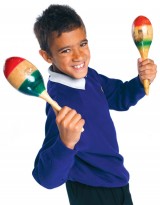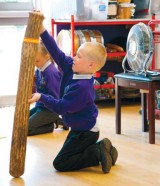With appropriate training, strategic partnerships and a few foolproof fillers...
The National Association of Music Educators (NAME) recently submitted a consultation document to Michael Gove. The opening paragraph states: ‘The National Curriculum recognises music as a key subject in a child’s learning, providing the opportunity for all children to develop a form of understanding that is both unique and also complements the other forms of learning. The National Curriculum for music has an international reputation. It promotes music as a way of knowing, developing musical understanding through practical engagement in performing, composing and listening. This embraces a breadth of musical styles, genres and traditions. England is regarded as a world leader in the development of children’s creativity through composition…’ (For the full response, see name.org.uk.)
There is nothing particularly wrong with the current primary music curriculum, and it is hoped that there will be no significant changes as a result of the current National Curriculum Review. What is required, however, is a more coherent programme of training; I think we would all agree that input about how to teach music on most primary teaching courses does not seem enough for students to feel competent to deliver a whole lesson – indeed, most foundation subject advisers would argue this is the case for their subject. Perhaps we should take a different approach, and ensure that what is provided in training is enough to deliverthe ‘ongoing’ skills. We could then offer a more structured course (such as the Trinity Guildhall Open University CPD programme, ksmusic.org.uk), once teachers are in post, have a year’s experience, and may feel confident enough to add full music lessons to the range of primary subjects they could deliver.
We have worked hard over the last few years to open up the classroom to music providers, peripatetic teachers and professional musicians. The most effective way to engage children with specialist music leaders is through a partnership. Planning is fundamental; something as simple as ensuring that everyone is using the same vocabulary will strengthen and embed pupils’ learning.
Parallels can be drawn across curriculum subjects. For example if you are learning about layers in music wouldn’t it make joined-up sense to the pupils if they were layering, say, fabrics or tissue in art? The connections across the curriculum are limitless and will reinforce the holistic nature of primary education.
This is equally important and effective if you find that someone else is timetabled to take the regularmusic lesson. Music is not content driven, so the curriculum can be quite flexible and the school can design themusic plan to marry in with content that may be fixed to specific terms in other subjects.
 Music as a subject has been recognised as requiring regular lessons of significant length (preferably one hour) – but it is also acknowledged that pupils benefit from a drip feed approach. We as primary teachers do this instinctively. For example, we may have songs for certain events in the day; the lining up song, or tidying up music. The primary day naturally lends itself to pockets of time where perhaps we have cleared up from art or changed back from PE faster than usual. Music is an ideal ‘filler’, so the class teacher, even if not the main music deliverer, should have a repertoire of five-minute activities – hence the QCA ‘on-going’ units.
Music as a subject has been recognised as requiring regular lessons of significant length (preferably one hour) – but it is also acknowledged that pupils benefit from a drip feed approach. We as primary teachers do this instinctively. For example, we may have songs for certain events in the day; the lining up song, or tidying up music. The primary day naturally lends itself to pockets of time where perhaps we have cleared up from art or changed back from PE faster than usual. Music is an ideal ‘filler’, so the class teacher, even if not the main music deliverer, should have a repertoire of five-minute activities – hence the QCA ‘on-going’ units.
Have a series of pieces of music, of various styles and types, linked to the current topic that could be used as background music while clearing up. For example, when we are doing ‘Water’ I play ‘Singing in the Rain’ and say I enjoy singing this when I splash through puddles in my wellies. But it also reminds me of the day I heard that Gene Kelly had died and I cried because I thought I would now never be able to dance with him! The impact it has on pupils, that empathy when I am talking about it… that’s what we can model and encourage children to find when they listen to music.
 There is nothing wrong with music supporting the rest of the curriculum. Singing is a proven way to embed and retain the learning of facts – we all have examples of information recalled from way back because they were part of a lyric. If you intend to use a song to enhance learning in another subject, though, try to ensure some input on improving something musical too. This could be the performance, the vocal quality or the assessment:
There is nothing wrong with music supporting the rest of the curriculum. Singing is a proven way to embed and retain the learning of facts – we all have examples of information recalled from way back because they were part of a lyric. If you intend to use a song to enhance learning in another subject, though, try to ensure some input on improving something musical too. This could be the performance, the vocal quality or the assessment:
1. Performance: make recordings and listen to progress made over time; take performance opportunities such as assemblies, singing to other classes or parents, or just being captured on a video.
2. Vocal quality: most song-books now have warm-ups and ways of teaching linked to sections and individual songs within collections. For more ideas on how to improve singing see the QCA scheme of work for music ‘on-going skills’ (units 1, 8 and 15) and the Sing Up website (singup.org).
3. Assessment: listening is a key skill, so make the most of every musical opportunity. Encourage quality listening by pairing up pupils with one other individual or group rather than everyone listening to everything. Ensure that this is modelled to the whole class so they understand and learn some techniques for positive feedback.
NAME (the National Association of Music Members) aspires to have a representative member in every primary school. If you are interested in finding out more then visit the NAME website name.org.uk
Teachers often feel that they have run out of repertoire – I regularly use this simple, fourline warm up as an example of how to take a piece and rework it. I’m not precious about the words or the tune; it’s placing the body percussion in a 4x4 grid that helps us become creative and begin composing new pieces.
• Imagine each line as a loop, which one groups sings round and round while the other three groups build up their loops (the tricky bit is getting the lyrics to flow so that the body sound/move happens on the correct beat)
• Gradually bring down the volume so just the body sounds are happening
• Listen and observe. The pupils may pick up on what is happening but if not, point at each group as they make the sound
• Ask the pupils to try to explain what is taking place – each sound is on a different beat (but not in the order we build them up)
• Now show them the grid and their particular ‘loop’
• Collect ideas for other body moves/percussion – suggesting that groups try and create new loops with them, changing the words to fit
First you make your fingers click
First you make your fingers click
Then you stamp your feet
Both hands slap your thighs
And clap on the beat.
| First you | make your | fingers | click |
| Then you | stamp your | feet | |
| Both | hands | slap | your thighs, And |
| Clap | on the | beat |
Supporting parents with maths
Ace-Maths
